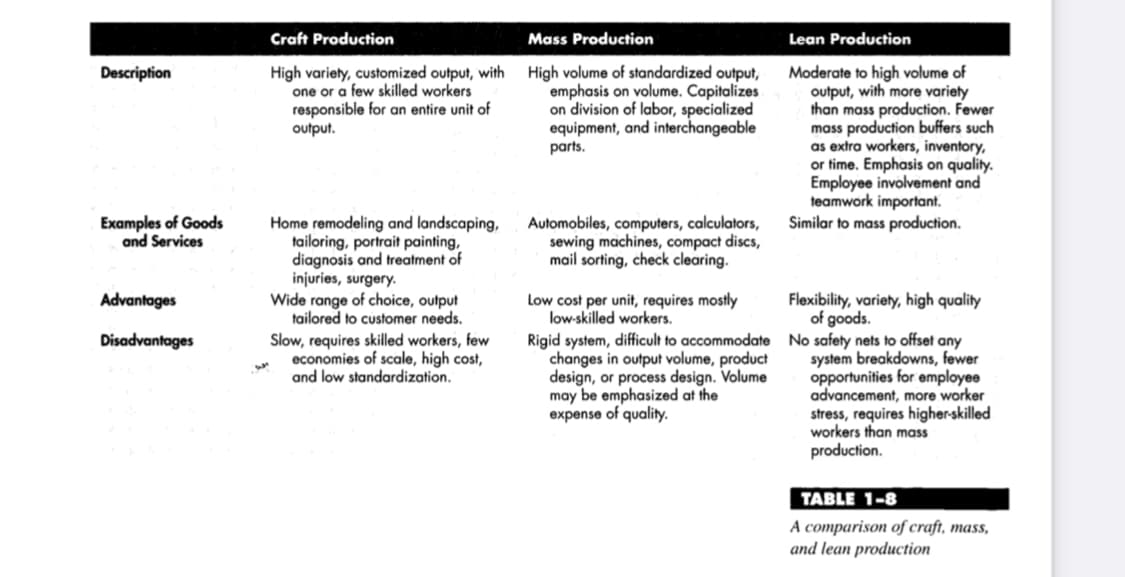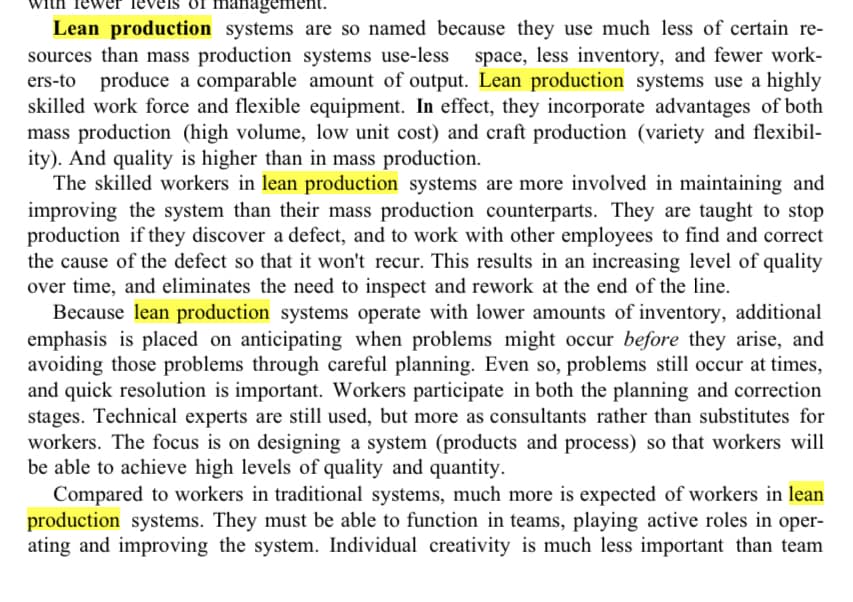Why might some workers prefer not to work in a lean production environment? Why might some managers resist a change from a more traditional mode of production to lean production? Important note: please refer to the given lesson in the photos attached. Use it as a basis. Thank you
Why might some workers prefer not to work in a lean production environment? Why might some managers resist a change from a more traditional mode of production to lean production? Important note: please refer to the given lesson in the photos attached. Use it as a basis. Thank you
Chapter1: Taking Risks And Making Profits Within The Dynamic Business Environment
Section: Chapter Questions
Problem 1CE
Related questions
Question
Why might some workers prefer not to work in a lean production environment? Why might some managers resist a change from a more traditional mode of production to lean production?
Important note: please refer to the given lesson in the photos attached. Use it as a basis. Thank you

Transcribed Image Text:Description
Examples of Goods
and Services
Advantages
Disadvantages
w
Craft Production
High variety, customized output, with
one or a few skilled workers
responsible for an entire unit of
output.
Home remodeling and landscaping,
tailoring, portrait painting,
diagnosis and treatment of
injuries, surgery.
Wide range of choice, output
tailored to customer needs.
Slow, requires skilled workers, few
economies of scale, high cost,
and low standardization.
Mass Production
High volume of standardized output,
emphasis on volume. Capitalizes
on division of labor, specialized
equipment, and interchangeable
parts.
Automobiles, computers, calculators,
sewing machines, compact discs,
mail sorting, check clearing.
Low cost per unit, requires mostly
low-skilled workers.
Rigid system, difficult to accommodate
changes in output volume, product
design, or process design. Volume
may be emphasized at the
expense of quality.
Lean Production
Moderate to high volume of
output, with more variety
than mass production. Fewer
mass production buffers such
as extra workers, inventory,
or time. Emphasis on quality.
Employee involvement and
teamwork important.
Similar to mass production.
Flexibility, variety, high quality
of goods.
No safety nets to offset any
system breakdowns, fewer
opportunities for employee
advancement, more worker
stress, requires higher-skilled
workers than mass
production.
TABLE 1-8
A comparison of craft, mass,
and lean production

Transcribed Image Text:nanagement.
Lean production systems are so named because they use much less of certain re-
sources than mass production systems use-less space, less inventory, and fewer work-
ers-to produce a comparable amount of output. Lean production systems use a highly
skilled work force and flexible equipment. In effect, they incorporate advantages of both
mass production (high volume, low unit cost) and craft production (variety and flexibil-
ity). And quality is higher than in mass production.
The skilled workers in lean production systems are more involved in maintaining and
improving the system than their mass production counterparts. They are taught to stop
production if they discover a defect, and to work with other employees to find and correct
the cause of the defect so that it won't recur. This results in an increasing level of quality
over time, and eliminates the need to inspect and rework at the end of the line.
Because lean production systems operate with lower amounts of inventory, additional
emphasis is placed on anticipating when problems might occur before they arise, and
avoiding those problems through careful planning. Even so, problems still occur at times,
and quick resolution is important. Workers participate in both the planning and correction
stages. Technical experts are still used, but more as consultants rather than substitutes for
workers. The focus is on designing a system (products and process) so that workers will
be able to achieve high levels of quality and quantity.
Compared to workers in traditional systems, much more is expected of workers in lean
production systems. They must be able to function in teams, playing active roles in oper-
ating and improving the system. Individual creativity is much less important than team
Expert Solution
This question has been solved!
Explore an expertly crafted, step-by-step solution for a thorough understanding of key concepts.
Step by step
Solved in 2 steps

Recommended textbooks for you

Understanding Business
Management
ISBN:
9781259929434
Author:
William Nickels
Publisher:
McGraw-Hill Education

Management (14th Edition)
Management
ISBN:
9780134527604
Author:
Stephen P. Robbins, Mary A. Coulter
Publisher:
PEARSON

Spreadsheet Modeling & Decision Analysis: A Pract…
Management
ISBN:
9781305947412
Author:
Cliff Ragsdale
Publisher:
Cengage Learning

Understanding Business
Management
ISBN:
9781259929434
Author:
William Nickels
Publisher:
McGraw-Hill Education

Management (14th Edition)
Management
ISBN:
9780134527604
Author:
Stephen P. Robbins, Mary A. Coulter
Publisher:
PEARSON

Spreadsheet Modeling & Decision Analysis: A Pract…
Management
ISBN:
9781305947412
Author:
Cliff Ragsdale
Publisher:
Cengage Learning

Management Information Systems: Managing The Digi…
Management
ISBN:
9780135191798
Author:
Kenneth C. Laudon, Jane P. Laudon
Publisher:
PEARSON

Business Essentials (12th Edition) (What's New in…
Management
ISBN:
9780134728391
Author:
Ronald J. Ebert, Ricky W. Griffin
Publisher:
PEARSON

Fundamentals of Management (10th Edition)
Management
ISBN:
9780134237473
Author:
Stephen P. Robbins, Mary A. Coulter, David A. De Cenzo
Publisher:
PEARSON